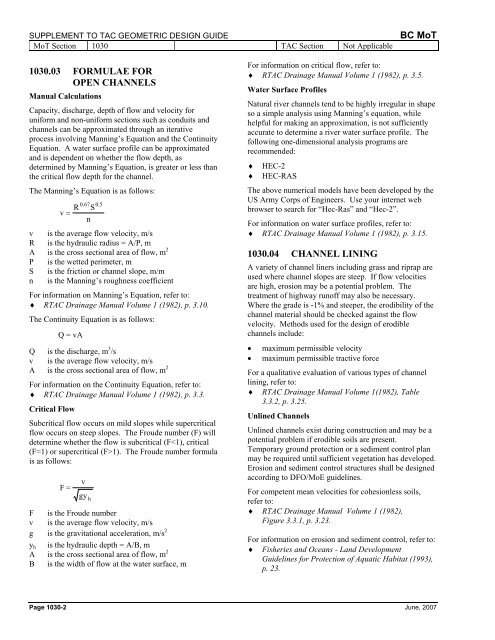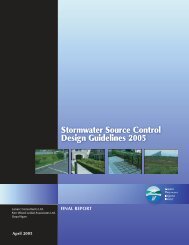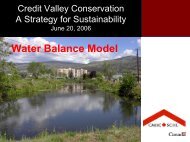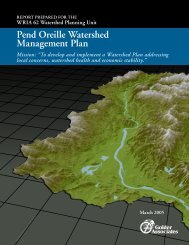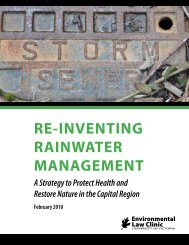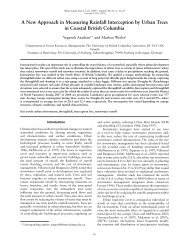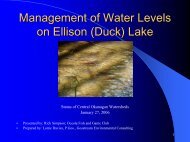1000 Hydraulics Chapter - Ministry of Transportation
1000 Hydraulics Chapter - Ministry of Transportation
1000 Hydraulics Chapter - Ministry of Transportation
You also want an ePaper? Increase the reach of your titles
YUMPU automatically turns print PDFs into web optimized ePapers that Google loves.
SUPPLEMENT TO TAC GEOMETRIC DESIGN GUIDE<br />
MoT Section 1030 TAC Section Not Applicable<br />
BC MoT<br />
1030.03 FORMULAE FOR<br />
OPEN CHANNELS<br />
Manual Calculations<br />
Capacity, discharge, depth <strong>of</strong> flow and velocity for<br />
uniform and non-uniform sections such as conduits and<br />
channels can be approximated through an iterative<br />
process involving Manning’s Equation and the Continuity<br />
Equation. A water surface pr<strong>of</strong>ile can be approximated<br />
and is dependent on whether the flow depth, as<br />
determined by Manning’s Equation, is greater or less than<br />
the critical flow depth for the channel.<br />
The Manning’s Equation is as follows:<br />
0.67 0.5<br />
R S<br />
v =<br />
n<br />
v is the average flow velocity, m/s<br />
R is the hydraulic radius = A/P, m<br />
A is the cross sectional area <strong>of</strong> flow, m 2<br />
P is the wetted perimeter, m<br />
S is the friction or channel slope, m/m<br />
n is the Manning’s roughness coefficient<br />
For information on Manning’s Equation, refer to:<br />
♦ RTAC Drainage Manual Volume 1 (1982), p. 3.10.<br />
The Continuity Equation is as follows:<br />
Q = vA<br />
Q is the discharge, m 3 /s<br />
v is the average flow velocity, m/s<br />
A is the cross sectional area <strong>of</strong> flow, m 2<br />
For information on the Continuity Equation, refer to:<br />
♦ RTAC Drainage Manual Volume 1 (1982), p. 3.3.<br />
Critical Flow<br />
Subcritical flow occurs on mild slopes while supercritical<br />
flow occurs on steep slopes. The Froude number (F) will<br />
determine whether the flow is subcritical (F1). The Froude number formula<br />
is as follows:<br />
F=<br />
v<br />
gy h<br />
F is the Froude number<br />
v is the average flow velocity, m/s<br />
g is the gravitational acceleration, m/s 2<br />
y h is the hydraulic depth = A/B, m<br />
A is the cross sectional area <strong>of</strong> flow, m 2<br />
B is the width <strong>of</strong> flow at the water surface, m<br />
For information on critical flow, refer to:<br />
♦ RTAC Drainage Manual Volume 1 (1982), p. 3.5.<br />
Water Surface Pr<strong>of</strong>iles<br />
Natural river channels tend to be highly irregular in shape<br />
so a simple analysis using Manning’s equation, while<br />
helpful for making an approximation, is not sufficiently<br />
accurate to determine a river water surface pr<strong>of</strong>ile. The<br />
following one-dimensional analysis programs are<br />
recommended:<br />
♦ HEC-2<br />
♦ HEC-RAS<br />
The above numerical models have been developed by the<br />
US Army Corps <strong>of</strong> Engineers. Use your internet web<br />
browser to search for “Hec-Ras” and “Hec-2”.<br />
For information on water surface pr<strong>of</strong>iles, refer to:<br />
♦ RTAC Drainage Manual Volume 1 (1982), p. 3.15.<br />
1030.04 CHANNEL LINING<br />
A variety <strong>of</strong> channel liners including grass and riprap are<br />
used where channel slopes are steep. If flow velocities<br />
are high, erosion may be a potential problem. The<br />
treatment <strong>of</strong> highway run<strong>of</strong>f may also be necessary.<br />
Where the grade is -1% and steeper, the erodibility <strong>of</strong> the<br />
channel material should be checked against the flow<br />
velocity. Methods used for the design <strong>of</strong> erodible<br />
channels include:<br />
• maximum permissible velocity<br />
• maximum permissible tractive force<br />
For a qualitative evaluation <strong>of</strong> various types <strong>of</strong> channel<br />
lining, refer to:<br />
♦<br />
RTAC Drainage Manual Volume 1(1982), Table<br />
3.3.2, p. 3.25.<br />
Unlined Channels<br />
Unlined channels exist during construction and may be a<br />
potential problem if erodible soils are present.<br />
Temporary ground protection or a sediment control plan<br />
may be required until sufficient vegetation has developed.<br />
Erosion and sediment control structures shall be designed<br />
according to DFO/MoE guidelines.<br />
For competent mean velocities for cohesionless soils,<br />
refer to:<br />
♦ RTAC Drainage Manual Volume 1 (1982),<br />
Figure 3.3.1, p. 3.23.<br />
For information on erosion and sediment control, refer to:<br />
♦ Fisheries and Oceans - Land Development<br />
Guidelines for Protection <strong>of</strong> Aquatic Habitat (1993),<br />
p. 23.<br />
Page 1030-2 June, 2007


